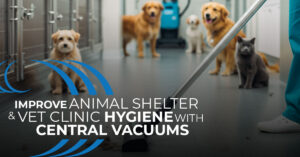
Boosting Productivity in Office Buildings with Central Vacuum
In today’s fast-paced work environment, maintaining a clean and organized office space is crucial for productivity. Office buildings often struggle with keeping their premises clean

Central vacuum systems have revolutionized home cleaning, offering a more efficient and convenient solution compared to traditional vacuum cleaners. But how do these systems work, and what makes them such an effective tool for maintaining a clean home? In this article, we delve into the mechanics of central vacuum systems, exploring their core components, functionality, and benefits.
A typical central vacuum system consists of several key parts, each playing a crucial role in its operation.
The power unit, usually located in a basement or garage, is the heart of the system. It houses the motor that generates suction and the dirt canister where all the collected debris is stored.
The piping system is a network of tubes hidden within the walls of your home. It connects the power unit to a series of inlet valves placed strategically around the house.
The hose is a lightweight, portable component that you plug into the inlet valves when you need to vacuum.
Finally, various attachments are available for different cleaning tasks, from brushes for carpets and hard floors to specialty tools for upholstery and crevices.
When you plug the hose into an inlet valve, the low voltage wiring system signals the power unit to start producing suction. As you move the hose and attachment across a surface, dirt and debris are sucked up, travel through the piping system, and end up in the dirt canister in the power unit. This process ensures a thorough, whole-house cleaning convenience.
One of the standout benefits of central vacuum systems is their ability to improve indoor air quality. Traditional vacuum cleaners can often recirculate dust and allergens back into the room. In contrast, central vacuum systems remove these particles from your living spaces and vent them outside your home. This results in cleaner, fresher air indoors, which can be particularly beneficial for those with allergies or asthma.
While the upfront cost of a central vacuum system can be higher than a standard vacuum cleaner, it’s a worthwhile investment for many homeowners. These systems offer superior cleaning power and convenience, and they also add value to your home. Plus, with their built-in nature, they’re always on hand whenever you need them, saving you the hassle of dragging out a heavy vacuum cleaner.
Like any home system, central vacuum systems may occasionally require troubleshooting. Common issues can range from blockages in the piping system to problems with the power unit or electrical system. However, with a basic understanding of the system’s mechanics, these issues can often be resolved quickly and easily.
In conclusion, central vacuum systems offer a powerful, efficient, and convenient solution for maintaining a clean home. By understanding their mechanics and how they work, you can ensure you’re getting the most out of your system. Whether you’re considering an investment in a central vacuum system or looking to optimize your current one, knowing the ins and outs of these systems can go a long way in enhancing your home cleaning routine.

In today’s fast-paced work environment, maintaining a clean and organized office space is crucial for productivity. Office buildings often struggle with keeping their premises clean

Central vacuums in animal shelters & vet clinic: Explore how these systems boost hygiene, efficiency, and air quality.

In the world of home entertainment, a home theater is a luxury that many homeowners dream of. It’s an immersive experience that brings the magic

A central vacuum system is a significant investment that promises convenience, powerful suction, and improved indoor air quality. However, choosing the right central vacuum hose
Our home automation products are at the forefront of technology, offering a blend of convenience, security, and efficiency. As a Homewave dealer, you’ll be part of a network transforming homes into smart, futuristic spaces.
Embark on this rewarding journey with us and leverage the power of innovative technology.
Please fill out this form and become a Homewave Dealer.